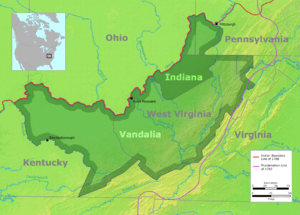Vandalia (colony) facts for kids
Vandalia was the name of a planned British colony in North America during the late 1700s. It was meant to be located south of the Ohio River. This area is mostly in what we now call West Virginia and northeastern Kentucky.
The British Crown never officially approved Vandalia. So, it never had its own government. However, some people from Virginia and Pennsylvania had already started to settle there. After the American Revolutionary War, these settlers tried to make Vandalia a new state called Westsylvania. But they didn't own the land legally. Also, the governments of Virginia and Pennsylvania both claimed the area.
In the end, the United States government divided the land between Pennsylvania and Virginia. This was done using the Mason–Dixon line. Kentucky later became a territory and then a state. West Virginia became a state much later, during the American Civil War.
Contents
The Idea of a New Colony

In the 1700s, British land investors often tried to start colonies in the Ohio Valley. A big attempt happened in 1748. The British King, King George II, allowed the Ohio Company to claim 200,000 acres of land. This land was near the "Forks of the Ohio" (which is now Pittsburgh, Pennsylvania).
However, two major conflicts stopped people from settling there. These were the French and Indian War (from 1754 to 1763) and Pontiac's War (from 1763 to 1766).
From Lost Goods to Land Claims
After Pontiac's War, some merchants had lost their trade goods. They formed a group called the "suffering traders." This group later became known as the Indiana Company. In 1768, a deal was made called the Treaty of Fort Stanwix. Through this treaty, the British made the Iroquois people give land to these "suffering traders."
The main people who gained from this were Samuel Wharton and William Trent. This land was called the "Indiana Grant." It was located along the Ohio River. It also included some hunting grounds that the Iroquois had controlled for a long time.
The Grand Ohio Company and Vandalia
In 1769, Wharton and Trent went to England. They wanted their land grant to be officially approved. There, they joined with the Ohio Company. Together, they formed the Grand Ohio Company. This group was also called the Walpole Company.
The Grand Ohio Company eventually received an even larger area of land than the Indiana Grant. These development companies planned a brand new colony. At first, they called it "Pittsylvania." But later, they changed the name to Vandalia. This name honored the British queen, Charlotte of Mecklenburg-Strelitz. People thought she was a descendant of the ancient Vandalic tribes.
Why Vandalia Never Happened
Other groups opposed the idea of Vandalia. Also, the American Revolutionary War (1775–1783) began. These problems stopped Vandalia from ever becoming a full colony.
During the Revolutionary War, some settlers in the region asked the American Continental Congress to recognize a new province. They wanted it to be called Westsylvania. This proposed state had almost the same borders as the earlier Vandalia plan. However, both Virginia and Pennsylvania claimed this region. So, they blocked the idea of a new state.
The Indiana Company tried to sue the State of Virginia over their land claims. But a court ruling made it impossible for citizens of one state to sue another state. So, the Indiana Company's lawsuit was dismissed.
Later, Kentucky became a state in 1792. Much later, West Virginia separated from Virginia in 1863. These events created the state borders we see in the region today.
See also
 In Spanish: Vandalia (Colonia) para niños
In Spanish: Vandalia (Colonia) para niños


